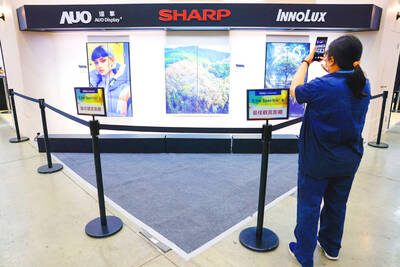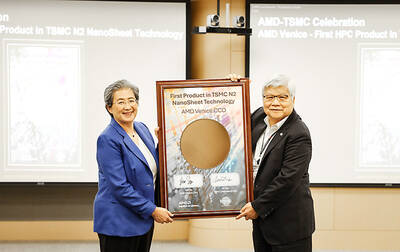AU Optronics Corp (AUO, 友達光電) and LG Display Co (LGD) might consider investing in low-cost G10.5 fabs to produce 65-inch and 75-inch LCD TV panels to capitalize on the increasing demand for big-screen TVs, IHS Markit said.
That would also elevate the competition in the global LCD panel industry to a new level, as only Chinese flat-panel makers are spending lavish funds on building G10.5 fabs, the market researcher said on Thursday.
FOUR NEW PLANTS
Four G10.5 plants are expected to enter operation in 2019 or 2020 in China, including those owned by BOE Technology Group (京東方) and China Star Optoelectronics Technology Co (華星光電), IHS Markit analyst David Hsieh (謝勤益) told reporters on the sidelines of an annual display forum in Taipei.
By the end of 2019, China is expected to control 45 percent of the world’s flat-panel market, while Taiwan and South Korea will have a 23 percent and 26 percent share respectively, the research house said.
“Chinese companies are targeting jumbo-size 65-inch and 75-inch TV panels,” Hsieh said. “However, the investment and consumption of resources are enormous, while technological barriers are high.”
A G10.5 production line would cost US$5.8 billion and would require 445 hectares of land, Hsieh said.
In comparison, a low-cost G10.5 production line would cost only about US$3 billion, or half of the amount required for a G10.5 line, he said.
For cost-sensitive companies like AUO, it will be an optimal choice, Hsieh said.
“AUO and LGD are considering building low-cost G10.5 lines to expand capacity, as demand for 65-inch panels is high,” he said.
AUO, Innolux Corp (群創), LG Display and Samsung Electronics Co are the world’s major suppliers of 65-inch TV panels, according to IHS Markit.
Hsieh said TV panel prices are to slide next quarter, snapping the longest streak of price increases in the industry’s history.
TV set makers have stockpiled large inventories due to concerns of supply constraints, he said.
TIGHT SUPPLY
Prices for most TV panels this month are generally flat from last month, according to IHS Markit.
Prices for 50-inch and 65-inch TV panels rose only between US$2 and US$5 per unit due to tight supply, it said.
However, Hsieh said he does not expect panel prices to collapse any time soon, as demand will outstrip supply by 5 percent.
“Supply will continue to be tight this year,” he said.
IHS Markit said it expects panel prices to remain stable this quarter, and the price trend in the second half of the year would depend on inventory digestion and shipments, as new capacity additions are not expected to be significant.

TAKING STOCK: A Taiwanese cookware firm in Vietnam urged customers to assess inventory or place orders early so shipments can reach the US while tariffs are paused Taiwanese businesses in Vietnam are exploring alternatives after the White House imposed a 46 percent import duty on Vietnamese goods, following US President Donald Trump’s announcement of “reciprocal” tariffs on the US’ trading partners. Lo Shih-liang (羅世良), chairman of Brico Industry Co (裕茂工業), a Taiwanese company that manufactures cast iron cookware and stove components in Vietnam, said that more than 40 percent of his business was tied to the US market, describing the constant US policy shifts as an emotional roller coaster. “I work during the day and stay up all night watching the news. I’ve been following US news until 3am

UNCERTAINTY: Innolux activated a stringent supply chain management mechanism, as it did during the COVID-19 pandemic, to ensure optimal inventory levels for customers Flat-panel display makers AUO Corp (友達) and Innolux Corp (群創) yesterday said that about 12 to 20 percent of their display business is at risk of potential US tariffs and that they would relocate production or shipment destinations to mitigate the levies’ effects. US tariffs would have a direct impact of US$200 million on AUO’s revenue, company chairman Paul Peng (彭雙浪) told reporters on the sidelines of the Touch Taiwan trade show in Taipei yesterday. That would make up about 12 percent of the company’s overall revenue. To cope with the tariff uncertainty, AUO plans to allocate its production to manufacturing facilities in

COLLABORATION: Given Taiwan’s key position in global supply chains, the US firm is discussing strategies with local partners and clients to deal with global uncertainties Advanced Micro Devices Inc (AMD) yesterday said it is meeting with local ecosystem partners, including Taiwan Semiconductor Manufacturing Co (TSMC, 台積電), to discuss strategies, including long-term manufacturing, to navigate uncertainties such as US tariffs, as Taiwan occupies an important position in global supply chains. AMD chief executive officer Lisa Su (蘇姿丰) told reporters that Taiwan is an important part of the chip designer’s ecosystem and she is discussing with partners and customers in Taiwan to forge strong collaborations on different areas during this critical period. AMD has just become the first artificial-intelligence (AI) server chip customer of TSMC to utilize its advanced

Six years ago, LVMH’s billionaire CEO Bernard Arnault and US President Donald Trump cut the blue ribbon on a factory in rural Texas that would make designer handbags for Louis Vuitton, one of the world’s best-known luxury brands. However, since the high-profile opening, the factory has faced a host of problems limiting production, 11 former Louis Vuitton employees said. The site has consistently ranked among the worst-performing for Louis Vuitton globally, “significantly” underperforming other facilities, said three former Louis Vuitton workers and a senior industry source, who cited internal rankings shared with staff. The plant’s problems — which have not